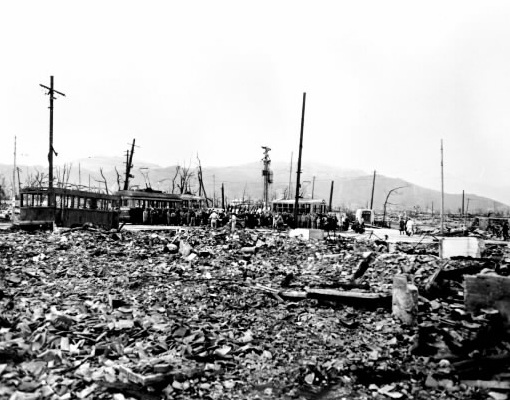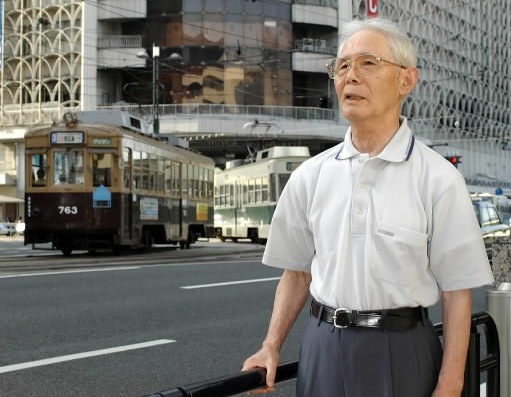Images of the Atomic Bombing, 1945~2003, Part 3
Jun. 26, 2010
Streetcars run through the burnt ruins
by Masami Nishimoto, Senior Staff Writer
In the summer of 2003, the Hiroshima Peace and Culture Foundation obtained 226 photographs from the U.S. National Archives which show the devastation caused by the atomic bombing. The photos the American forces took in their investigation of the effects of the bombing are witnesses that convey the tragedy of that time. This series [originally published in July and August 2003] traces the reality of the atomic bombing through some of these images.
Driving on while battling the A-bomb's aftereffects
This photograph features streetcars standing amid the vast rubble of the atomic blast. The streetcar on the far left is a charred husk while the others have resumed service. In front of the streetcars is a jeep and some husky soldiers standing before men in national uniforms and women in bulky work pants. Judging from the view of the mountains, the image was taken from the southeast and shows the area of the Kamiya-cho intersection, now part of the busiest city center in the Chugoku-Shikoku region. The streetcar line was partially restored on September 7, 1945 between Sakan-cho (now Honkawa-cho, Naka Ward) in the west and Hatchobori in the east. Despite barely escaping death themselves, the streetcar crews helped transport the A-bomb survivors in the aftermath of the bombing.
After taking part in rigorous military training on August 5, Kaname Nishigame, 75, now a resident of Naka Ward, was still in bed at 8:15 a.m., the time the atomic bomb exploded on the following day, August 6. He was on the second floor of the Hiroden Streetcar Company's dormitory, 1.9 kilometers from the hypocenter, near the Sendamachi Substation. He jumped up, startled by a thundering roar. Blood flowed from his right arm, coating his body.
He fled to Ninoshima Island. “When I saw ominous black clouds swirling in the sky, I couldn't stay there any longer," and he returned to the city by crossing the bay.
The next day, August 7, three teams were formed to engage in repairs to the streetcar system and other work. Mr. Nishigame, a driver, went out in search of fellow employees. As many of the male workers had been called away into military service, students still in their teens, from the Home Economics Girls' School attached to the Hiroden Streetcar Company, which was opened in 1943, took up roles on the streetcars. They not only served as conductors, but as drivers, too, after learning how to operate the streetcars by watching the real drivers at work.
At the Yagurashita streetcar stop located near the T-shaped Aioi Bridge, the target of the atomic bomb, "there were people with their eyeballs popping out, who couldn't be identified as male or female." At the Tokaichi stop, 700 meters west of the hypocenter, Mr. Nishigame managed to recognize the body of one of the students from the clasp of a bag and a hole punch used in taking tickets.
The town resting on the delta, with seven rivers running peacefully through it even in wartime--the familiar scenery he had always seen from his driver's seat--the whole environment had undergone an astonishing change.
The company's history and other materials cite 211 employees as casualties of the bombing. Thirty students were killed, too. Of the 123 streetcars, 108 were rendered inoperable. The number of passengers who died that day cannot be confirmed.
Streetcar operations were first resumed on August 9 between Koi and Tenma-cho relying on electricity supplied from the Hatsukaichi Substation, 15 kilometers west of the city.
Haruno Horimoto, 73, who now lives in Higashi Ward, was a second-year student of the Home Economics Girls' School. She was serving as a conductor when the streetcar resumed service.
"The passengers all had burns and injuries, and they were searching for missing family members," Ms. Horimoto recalled. "We didn't have any tickets or money, and I could barely stand myself." She was exposed to the atomic bomb at the school's dormitory, which was destroyed by the blast. Her mother, Aki Akamatsu, who was 41 at the time and working at an inn near the Aioi Bridge, went missing.
The supply of electricity from the Sendamachi Substation restarted on August 18, three days after the radio broadcast of the Emperor announcing Japan's defeat. Operation of the tracks between the Hiroden headquarters and Ujina also resumed that day. After the bombing, sustained by his youthful strength of age 18, Mr. Nishigame had been carrying messages between the headquarters and Koi in the west where the Miyajima Line originated. On that same day he was again placed in the driver's seat.
"My diarrhea continued for a month," he said. "My hair fell out. I was in bad shape."
"But still you kept driving," I responded. "Did you risk your health out of a sense of mission?"
"I don't know," he said. "I don't think we were collecting fares." He smiled wanly and told me about the streetcar running again through the scorched ruins of the city. The entire line was restored in December 1948, three years after the bombing.
In albums arranged by his wife Masako, 69, are photos of colorfully decorated streetcars that ran on happy postwar occasions, such as the wedding of Japan's Crown Prince in 1959 and the first championship for the Hiroshima Toyo Carp Baseball Team in 1975, as well as photos taken when he was recognized for his record of driving without an accident. After retiring in 1987, he continued working as a part-time conductor for five more years. Battling the A-bomb's aftereffects for 50 years, he nevertheless devoted himself to the operation of the streetcars of Hiroshima.
The total line runs 18.8 kilometers. The streetcars that were operated by drivers and conductors who escaped death now transport over 100,000 passengers each day. The four Model 650 cars that were manufactured in 1942, the year Mr. Nishigame joined the company--and to which he refers to with affection as "my classmates"--are still carrying passengers in the town on the delta.
(Originally published on July 31, 2003)









